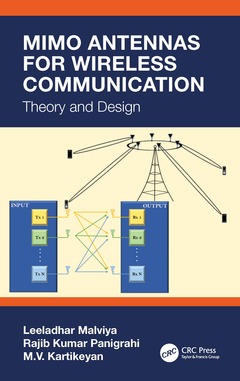Description
MIMO Antennas for Wireless Communication
Theory and Design
Authors: Malviya Leeladhar, Panigrahi Rajib Kumar, Kartikeyan M.V.
Language: English
Subjects for MIMO Antennas for Wireless Communication:
57.55 €
In Print (Delivery period: 14 days).
Add to cartPublication date: 09-2023
· 15.6x23.4 cm · Paperback
154.17 €
In Print (Delivery period: 14 days).
Add to cartPublication date: 12-2020
· 15.6x23.4 cm · Hardback
Description
/li>Contents
/li>Biography
/li>
The desired objective of this book is to investigate diversity and mutual coupling effects on MIMO antenna designs for WLAN/WiMAX/LTE applications, controlled with diversity and ground modification techniques including equivalent circuit diagrams. Diversity techniques in MIMO antennas leading to the performance improvement ratings are demonstrated and deliberated. The book contributes towards the development of 2:1 VSWR MIMO antennas with diversity techniques for indoor/outdoor applications for high data rate, QOS, and SNR. The improved MIMO antenna structures are investigated and presented in this book including part of massive MIMO to provide the important aspects of emerging technology. Aimed at researchers, professionals and graduate students in electrical engineering, electromagnetics, communications and signal processing including antenna theory and design, smart antennas, communication systems, this book:
- Investigates real time MIMO antenna designs for WLAN/WiMAX/LTE applications.
- Covers effects of ECC, MEG, TARC, and equivalent circuit.
- Addresses the coupling and diversity aspects of antenna design problem for MIMO systems.
- Focus on the MIMO antenna designs for the real time applications.
- Exclusive chapter on 5G Massive MIMO along with case studies throughout the book.
Leeladhar Malviya received his Ph.D from IIT Roorkee, India in 2017. He received his ME in Electronics and Telecommunication Engineering from Shri G. S. Institute of Technology and Science, Indore, India, in 2008, and BE in Electronics and Communication, from the Govt. Engineering College, Ujjain, India, in 1998. Since 2001, he has been with Shri G. S. Institute of Technology and Science, Indore (MP), India, and serving as an Associate Professor. His current research interests include compact multiple-input-multiple-output (MIMO) antennas for high data rate communications for 4G, 5G, and THz planar microstrip antennas, fractal antennas, and metamaterial antennas for communication. He is a Member of IEEE, Institution of Electronics and Telecommunications Engineers (IETE, India), Institution of Engineers (IE, India), and Indian Society for Technical Education (ISTE). He is the reviewer of IET (Microwaves, Antennas & Propagation – MAP), PIER (Progress In Electromagnetics Research of the Electromagnetics Academy, USA), and Int. Journal of RF and Microwave Computer Aided Engineering.
Rajib Kumar Panigrahi received PhD degree from IIT Guwahati, India in 2011. He received M. Tech. degree from CUSAT, Kerala, India and B.E. degree in Electronics and Communication from Bangalore University (Now VTU), India. Since 2012, he has been with IIT Roorkee, India, where he is currently serving as an Associate Professor in the Department of Electronics and Communication Engineering. His current research focuses on Radar signal processing, Radar based remote sensing, target detection, and Denoising, segmentation and classification of polarimetric SAR images, and MIMO antenna design.
Professor M.V. Kartikeyan received the Master of Science and Ph.D. Degrees specializing in Advanced Electronics and Radio Physics and Electronics Engineering from Banaras Hindu University and IIT-BHU, Varanasi, India, in 1985 and 1992, respectively. He was a Research Scientist with the
These books may interest you

AntennasFrom Theory to Practice 110.98 €

Printed MIMO Antenna Engineering 181.19 €


